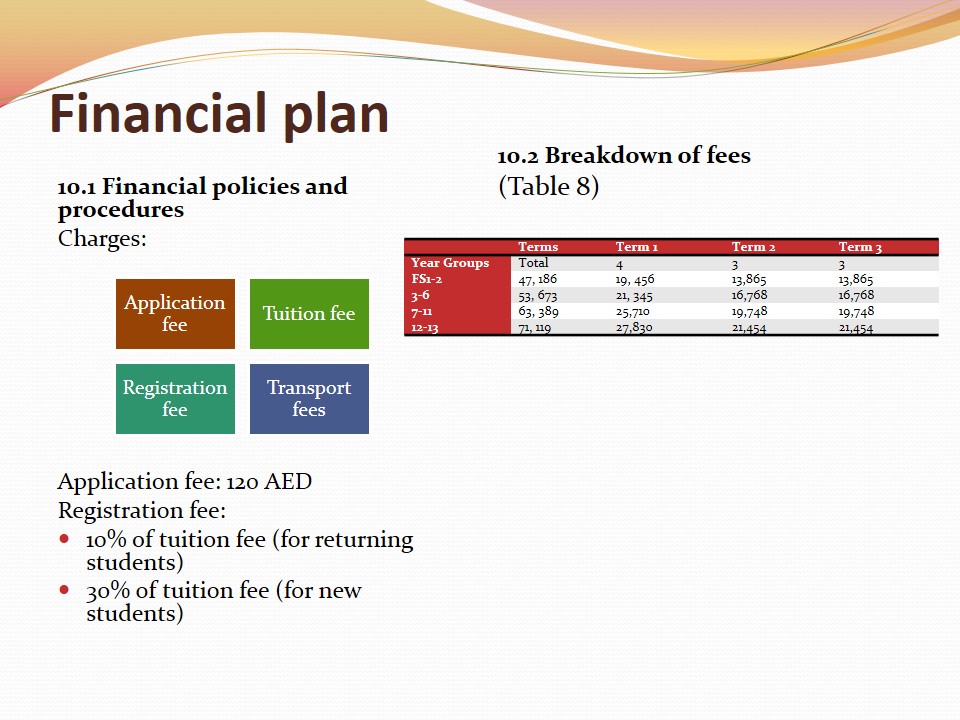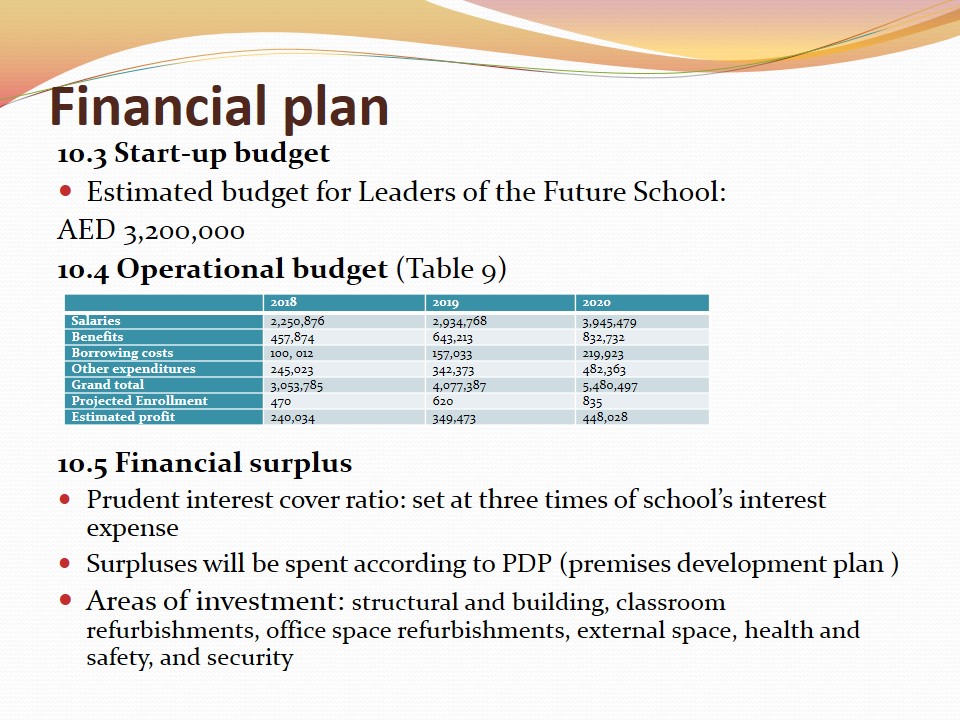Overview of the Academic Plan
- Applicants’ names, profiles and contact details.
- Type of school:
- New educational institution.
- Name and address:
- Leaders of the Future School is an English National Curriculum School in Nad Al Sheba.
- Proposed year and month of opening:
- September of 2018
- Proposed curriculum:
- National Curriculum of England with Early Years Foundation Stage (FS1 and FS2)
- the General Certificate of Secondary Education (GCSE)/ the International General Certificate of Secondary Education (IGCSE) (10-11)
- A-Level the Business and Technology Education Council (BTEC) National Diploma (12-13).
- Gender and Grade/Year groups
- Goal: 50/50 ratio of boys to girls.
- Instruction time:
- Proposed school premises:
- One level: 1000 K1-12 students and 200 FS1&FS2 students.
- Total site area 10, 400 m2.
- 65 classrooms, 7 offices, 3 rooms for the use of staff, and 10 science laboratories.
- 3 gyms, 3 fitness rooms.
- Proposed language(s) of instruction:
- English as main language for instruction delivery.
- Arabic as additional language.
- Admissions policy:
- Students of all ethnic backgrounds, abilities, and races.
- Staff children –prioritized.
- Admission start: February 1st, continue for 4 days.
- Documents required: birth certificate (photocopy), passport, ID card, immunization records, 4 photographs of a child.
- Management of the school:
- Partnership with Innoventures Education.
Table 1. Grade/Year Groups of the School
Table 2. Instruction Time
The size of classrooms will allow each student in the school to have 1.5 m2 of space.
The institution’s library will provide students with frequent access to a wide range of educational materials during school hours. The library will be managed by a teacher-librarian. All classrooms of Leaders of the Future School will be connected to modern information and communication technology infrastructure, which will help to attain outstanding levels of educational achievement. The school will have twelve specialized science laboratories (physics, chemistry, and biology), three laboratory preparation rooms, two multi-purpose auditoriums, five art rooms, four performing art rooms, and two special needs bases. All facilities will be designed to facilitate the mobility of physically disabled students.
Leaders of the Future School will have 48 toilets and washrooms, the floors and walls of which will be covered with ceramic tiles, thereby allowing for effective disinfection (Government of Dubai, 2013). The rooms will feature hand sanitizers and hygiene education materials. The school will also have two prayer rooms for boys and girls separately. The rooms will have ablution areas.
The indoor areas of the gymnasiums will have separate locker rooms as well as shower and toilet facilities for each sex (Mbaka, Elias, & Muthaa, 2012). The flooring of the premises will be covered with proper cushioning, which is necessary to ensure safe participation of all students. Gross building area of the school will be 1, 400 m2. It will be composed of the following areas: halls, dining, and PE (385 m2), learning resources (135 m2), staff and administration (110 m2), storage (160 m2), float (200 m2), and non-net area (410 m2). Total site area of the institution will be 10, 400 m2. It will include soft outdoor PE (6,000 m2), hard outdoor PE (500 m2), soft informal and social area (700 m2), hard informal and social area (300 m2), float (900), and non-net area (2, 000 m2). Float areas will be used to change parameters of other areas (Department for Education, 2014).
KG/FS learning classrooms will have large meeting areas in the center, which will provide young students with a shared learning experience. The areas will be equipped with flipchart stands, big book stands, individual carpet mats, and a flannel story board. The classrooms will also have miscellaneous areas for reading, listening, writing, numeracy, science, technology, art, and dramatic play, which will be located around its perimeters.
Students applying for KG1 and KG2 will participate in an informal interview during which age appropriateness, bathroom independence, and ability to separate from parents will be assessed (International Community School, n.d.). Junior students’ mathematics, Arabic, and English skills will be tested during the admission process in order to better understand areas of strength and development (International Community School, n.d.). Caregivers of children with special education needs will have to notify the school about such needs in order to help teachers to make “reasonable adjustments that may enable students to continue successfully their education” (International Community School, n.d., p. 2). The applications will be reviewed by the school’s principal and SEND education teachers in order to determine whether the institution is capable of accommodating the needs of the children.
The company is a leading School Improvement Partner in Dubai that will “lead and manage school improvement services and deliver the school improvement strategy ensuring that quality and standards continue to improve” (ISS, 2017, p. 10). Innoventures Education will provide expert advice necessary to improve educational outcomes of the institution.
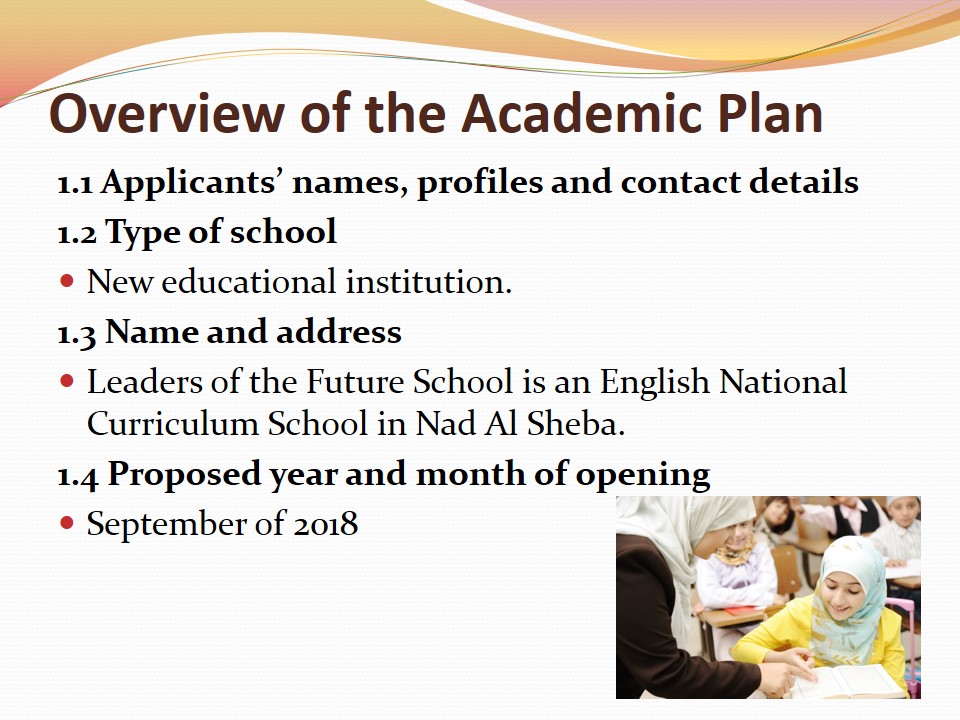
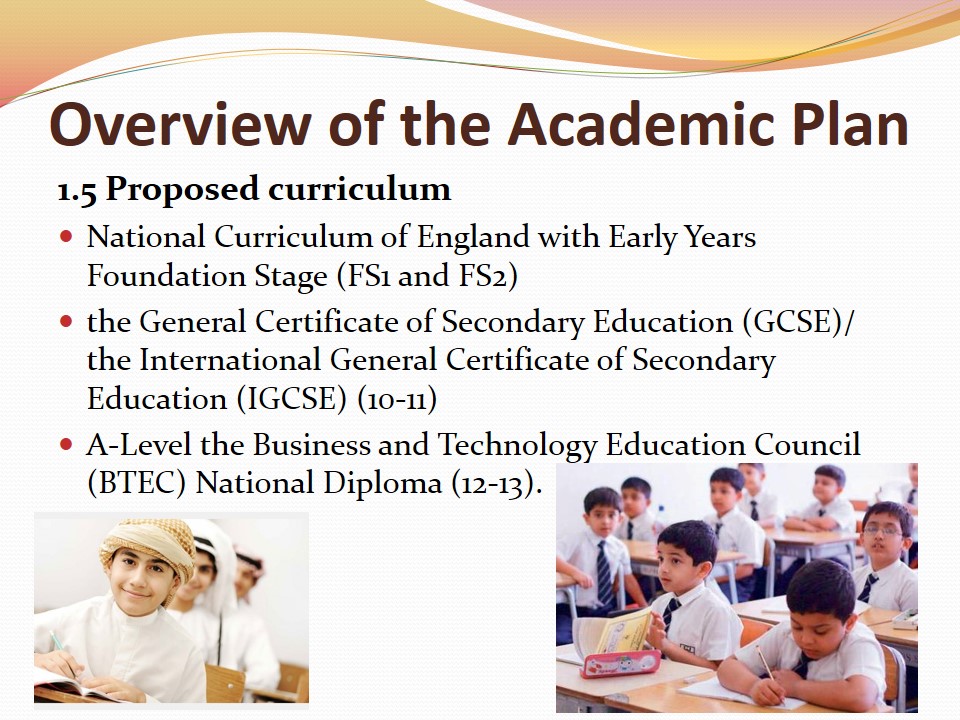
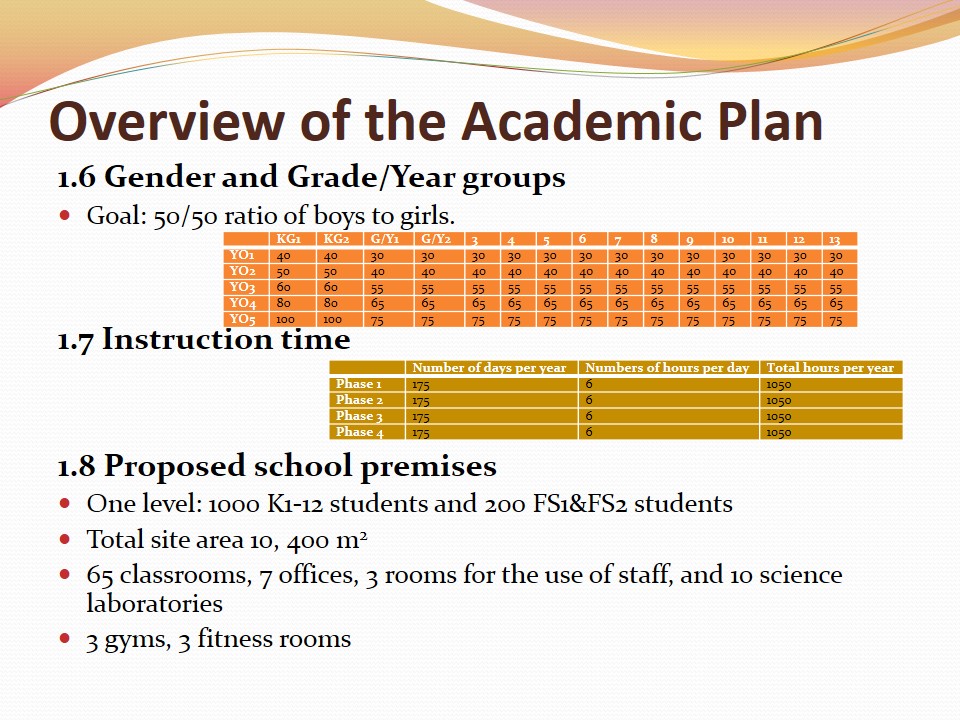
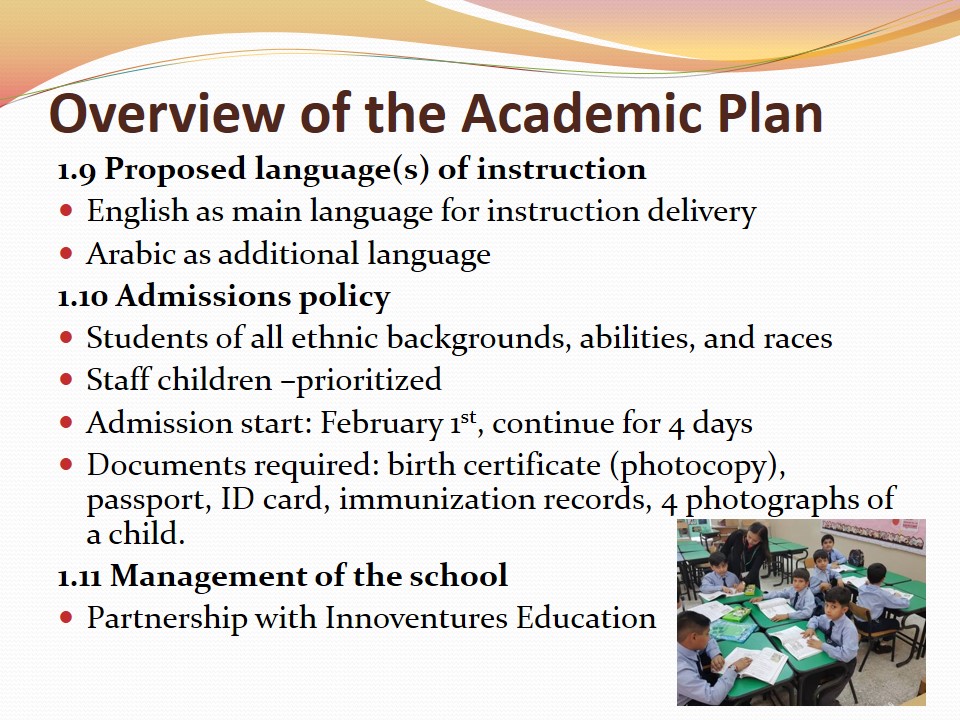
Provision for Emirati Students
Attracting, admitting and retaining Emirati students:
- Catering to caregivers’ preferences in education:
- Attracting new students;
- Retaining clients.
- School fairs:
- Promotion of services;
- New recruitments.
Using student achievement data:
- Data analysis;
- Feedback provision;
- Data collection.
Supporting Emirati students’ educational success, achievement:
Pedagogical approach:
- Safe and supportive educational environment;
- High expectations from educators;
- Satisfaction of learners’ psychological needs;
- Cultural awareness;
- Community building;
- Social bonding.
Ensuring that Emirati students know their potential and feel supported to set goals and take action to enjoy success:
- Child Development Project (CDP)
Providing a teaching and learning environment that is relevant, engaging, rewarding and positive:
- Innovative Learning Environments (ILE)
Ensuring that Emirati students gain the skills, knowledge and qualifications they need to achieve success in the United Arab Emirates and the wider world:
- Critical thinking;
- Creativity;
- Research;
- Oral and written communication;
- ICT literacy;
- Leadership;
- Planning;
- Health and wellness literacy;
- Global awareness.
The school’s Child Development Project (CDP) will help students to strengthen their autonomy and self-direction which are the main prerequisites of academic success (Schaps, n.d.). The program revolves around family involvement activities that are designed to improve academic motivation.
The Innovative Learning Environments (ILE) project will be conducted in the school in order to address organizational and individual issues associated with the creation of engaging learning environment (OECD, 2012). The project will help to nurture strong social bonds; therefore, it will contain cooperation and communication activities.
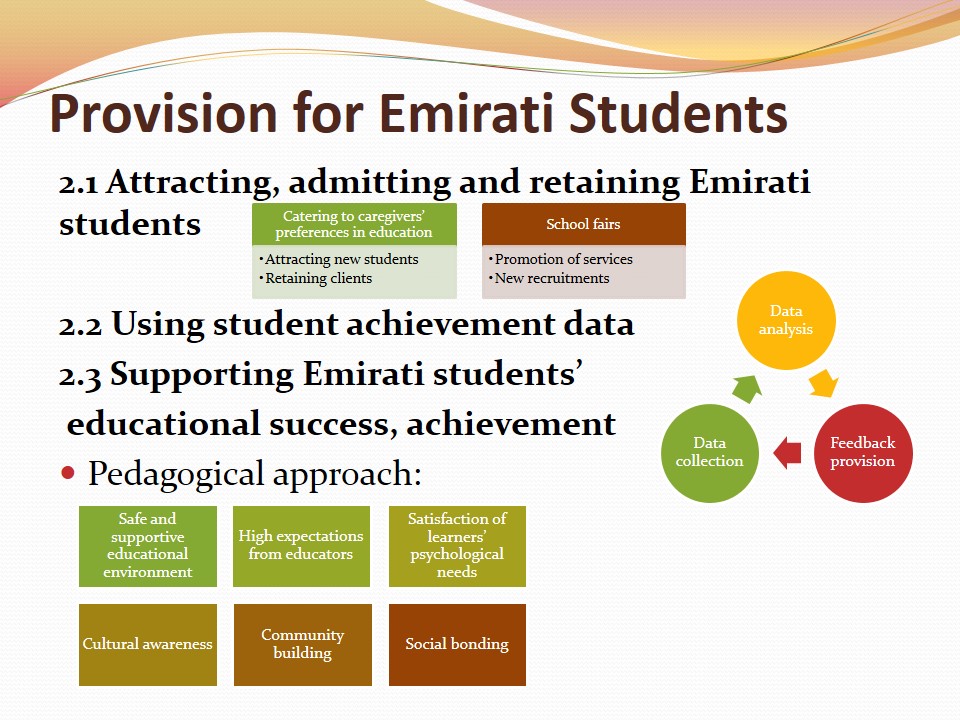
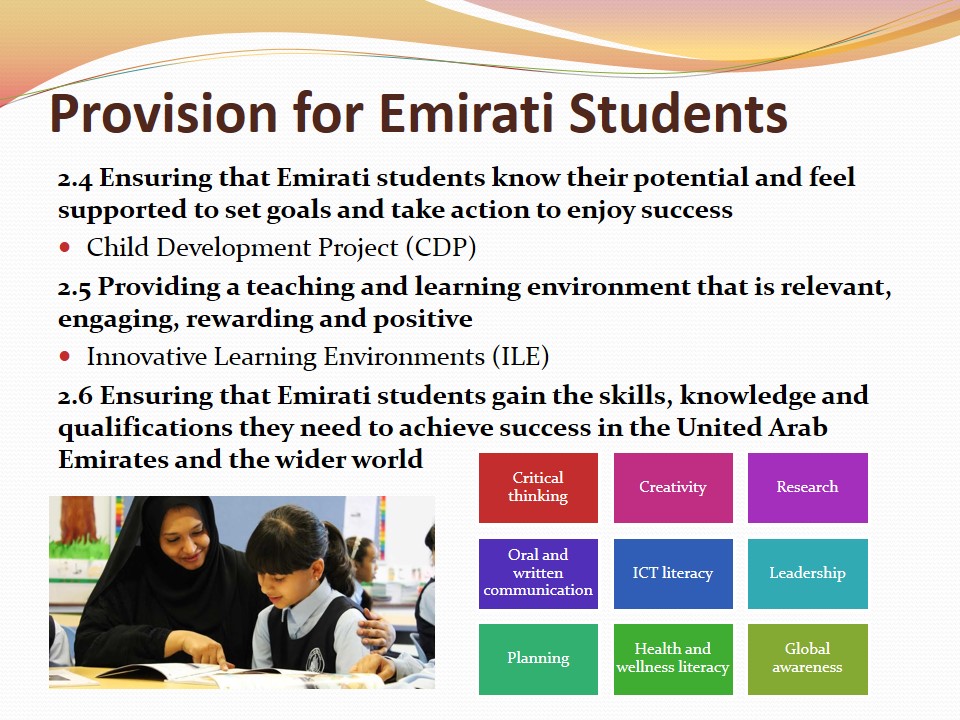
Ministry of Education Priorities
- Arabic language :
- Philosophy:
- empowerment, promotion of cultural identity.
- Leadership:
- a team of experts with extensive experience in teaching Arabic.
- Curriculum:
- a curriculum designed by the Ministry of Education (MOE), a balanced language learning environment.
- Assessment:
- The MOE’s decree no. 547 will be used to assess language skills of the school’s students.
- Resources:
- online recruitment campaign to attract excellent teaching talent.
- Governance:
- MOE’s statutory requirements with respect to staffing levels, educational resources, and curriculum.
- Philosophy:
- The UAE National Agenda
- The engagement of Innovative Education professionals to meet the National Agenda Parameter.
- Provision for inclusion
- Every Child Matters policy (for equal opportunity).
- Identification and categorization of special needs students.
- Work with high achievers and gifted students.
- Parental inclusion.
- Innovation
- The creation of innovation-oriented culture.
- Addressing barriers to innovation.
- The provision of resources for staff development and self-realization.
Students with special educational needs and/or disabilities (SEND) will be divided into four broad categories: communication and interaction, cognition and learning, social difficulties, and sensory/physical needs (Lendrum, Barlow, & Humphrey, 2013). The institution’s Special Educational Needs Coordinator and Inclusion manager will be responsible for identifying children with SEND at different stages of their education. The school’s Deputy Head Teacher for Inclusion will identify high achievers and gifted students and set priorities for their development.
Leaders of the Future School will regularly gather information on academic achievement and personal/social/emotional development of students with SEND, higher achievers, and gifted students in order to modify its curriculum, thereby closing an attainment gap. The school recognizes the role of parents in helping students to achieve their full potential; therefore, caregivers will be encouraged to actively participate in the decision-making process.
leadership of the institution will train staff members to think like leaders and entrepreneurs, which will help them to channel their energy into the creation of new systems within the organization. The school’s infrastructure will be modified to mitigate the impact of the following barriers to innovation: weak incentives to change, micro-management, regulation, and standardization.

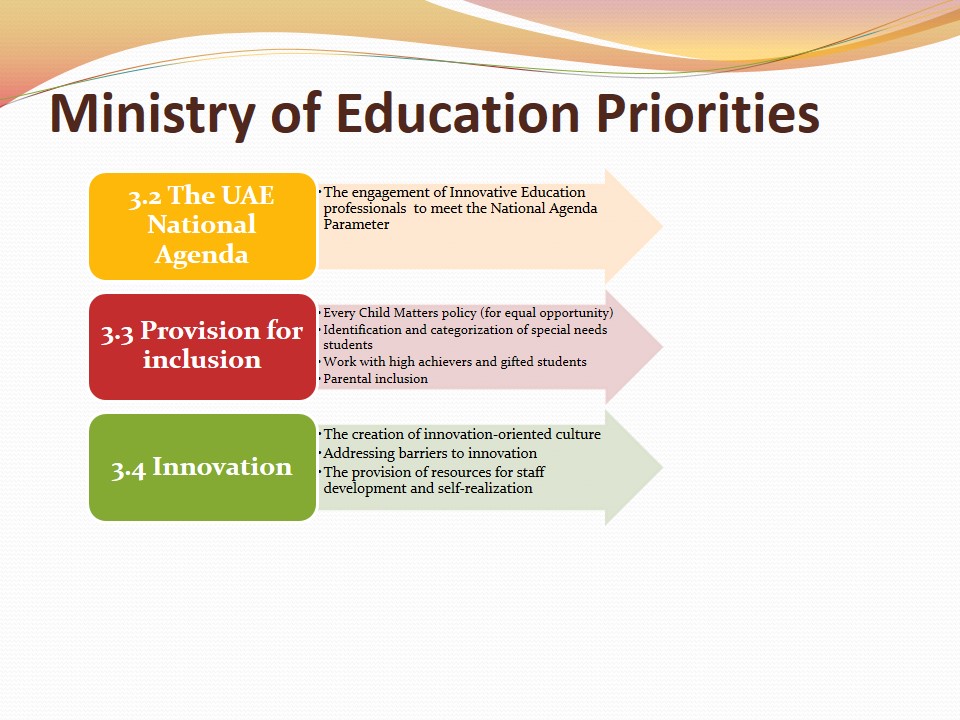
Vision, Mission, Rationale and Quality Assurance
- School vision: to support young learners in becoming confident lifelong achievers who are ready to embrace opportunities of the modern world.
- School mission: to deliver education that reflects Islamic values while emphasizing on global mindedness and innovation, to nurture students’ ability to think critically and help them to become responsible citizens of tomorrow.
- Rationale for the proposal
- Population growth.
- Large community.
- Need for more schools.
- Quality assurance
- Evaluation: How are we doing?
- How do we know?
- How well should we be doing?
- Planning for improvement: What are we going to do now?
- Implementing out action plan
- Monitoring: Are we doing what we have agreed?
Rationale: According to a population bulletin issued by the government of Dubai, more than 4, 000 people lived in four sub-communities of Nad Al Sheba in 2015 (Dubai Statistics Center, 2015). With an average population growth of 2.47 percent, it is expected that Kings’ School Nad Al Sheba will not be capable of accommodating all children of the community (Index Mundi, 2017). Therefore, the growth in the district’s population is an opportunity to be explored. The proposal is aligned with the educational provision of Dubai because it will help to achieve the growth of the private sector in primary and secondary schooling.
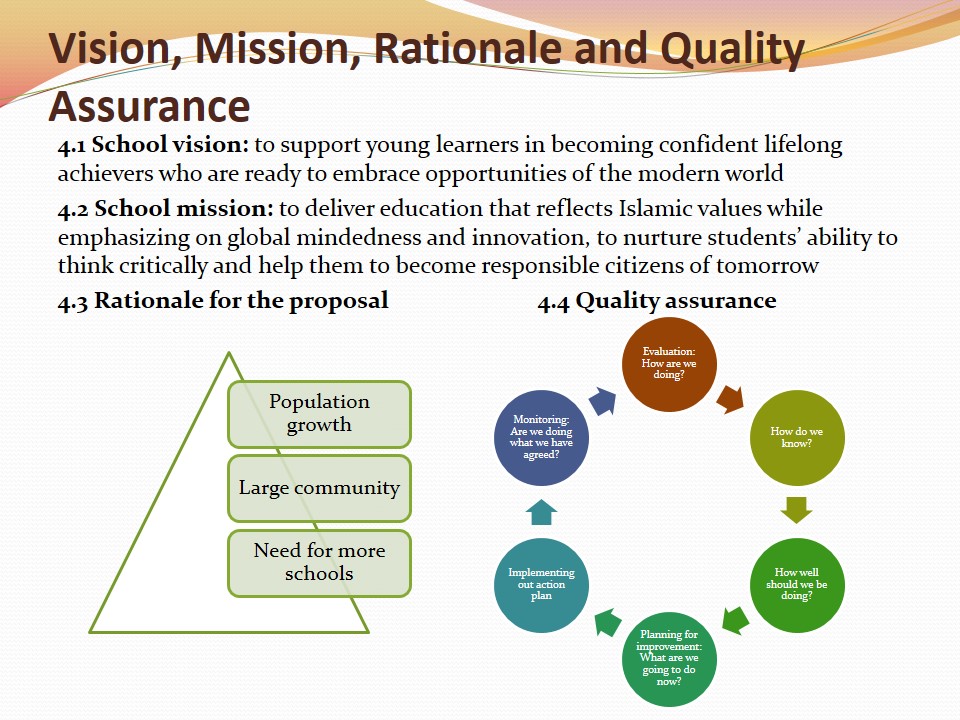
Curriculum
- Introductory statement:
- Personal and social development. of learners.
- Development of engaged learners.
- Promotion of Islamic values.
- Based on the English National Curriculum.
- Statutory requirements
- Rigorous standards of Islamic education.
- Arabic as a first language, Arabic as an additional language.
- Extra-curricular provision (Table 3).
- Provision for students whom the language of instruction is an additional language:
- Support for non-native students.
- Staff trained to work with non-native learners.
- Information for parents about extra curricular activities and their costs.
- Learning resources:
- Textbooks;
- Education packs;
- Films;
- Lesson plans;
- Tablets;
- Worksheets and workbooks.
- Happiness:
- Regular extracurricular activities:
- Food festivals;
- Marathons;
- WOWs:
- the Walls of Well-Being;
- Stronger image for the institution.
- Regular extracurricular activities:
Students willing to pursue higher education in an Arab country will be offered addition lessons in these subjects during years 12 and 13 of senior school.
Table 3. Extra-curricular Provision in Leaders of the Future School.
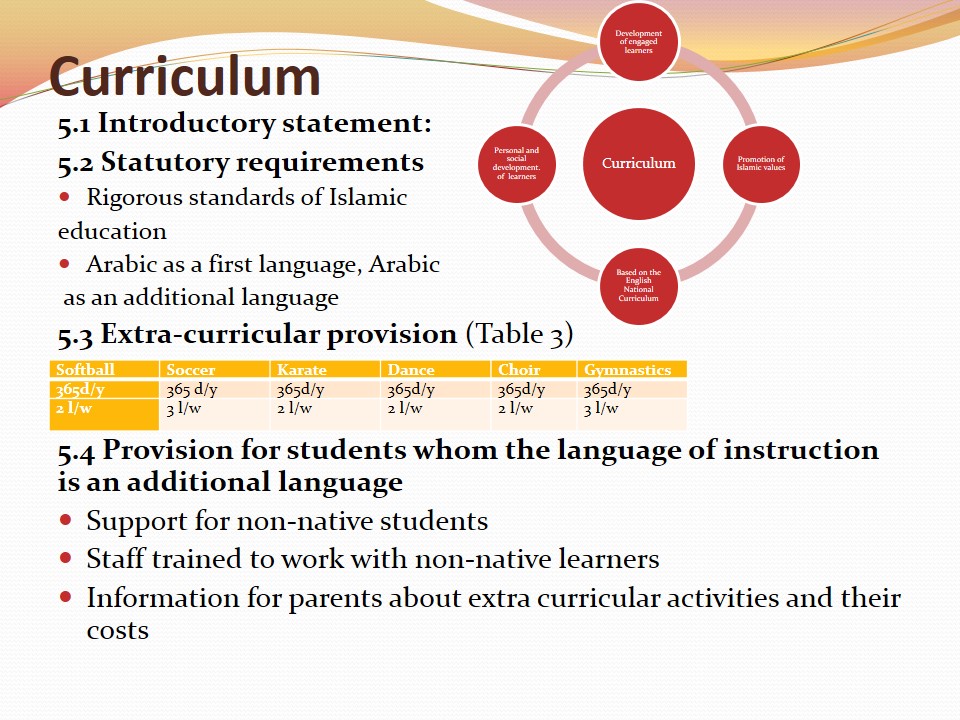
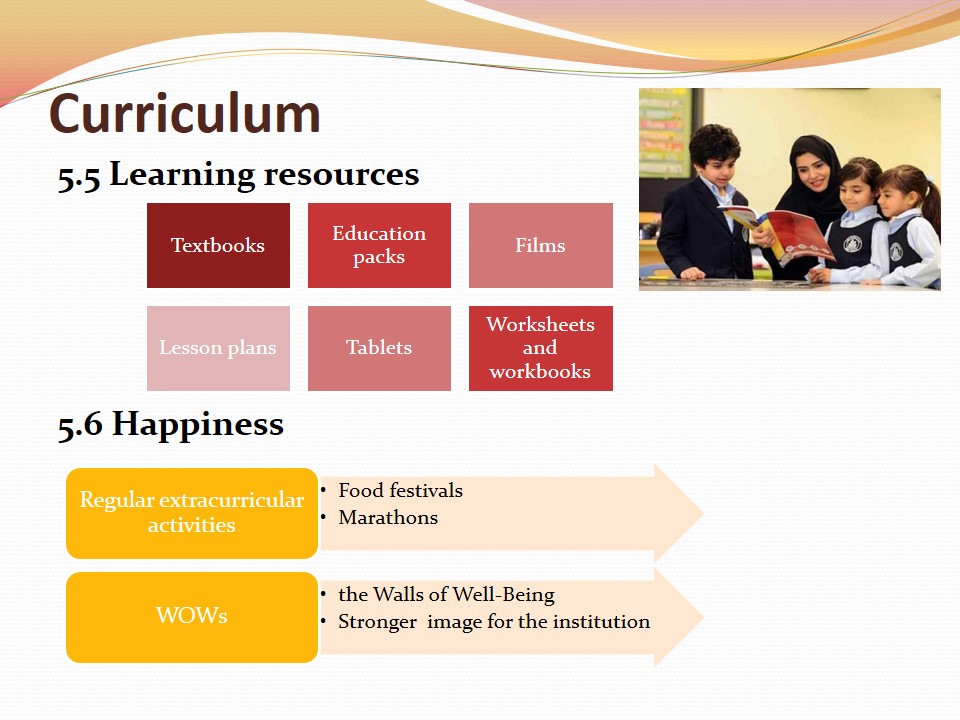
Teaching, Learning, Assessment
- Strategies for teaching and learning:
- Adaptive teaching;
- Learning through argumentation and discussion;
- Crossover learning, incidental learning, and context-based learning.
- Supporting the needs of individual students:
- Identification and assessment of special needs students;
- Individual education plans, outcomes monitoring;
- Staff trained to work with special needs students.
- Assessment plan (Table 4):
- Reporting to and consulting parents:
- Daily contacts.
- Regular meetings.
- Written progress reports.
- Home visits.
Table 4 presents the institution’s assessment plan.
Performance of the school’s students will be regularly evaluated at appropriate stages. Students with SEND will be subjected to SPED summative assessment.
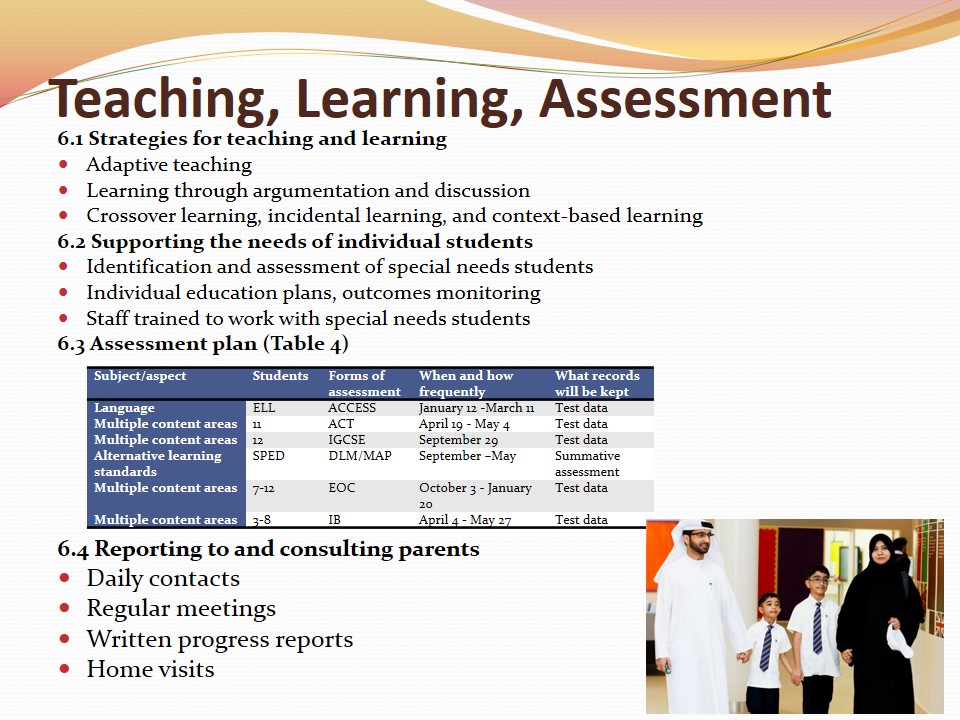
Behavior and Attendance
- Student attitudes and behavior policy:
- RtI model.
- Response to Intervention model.
- Systematic and hierarchical decision-making process to assign evidence-based strategies based on student need and in accordance with regular progress monitoring.
- Attendance:
- All students are expected to attend school regularly.
- Failure to do that will result in the following measures:
- Parent calls;
- Referral to the school’s administrator;
- Discipline contract;
- Suspension.
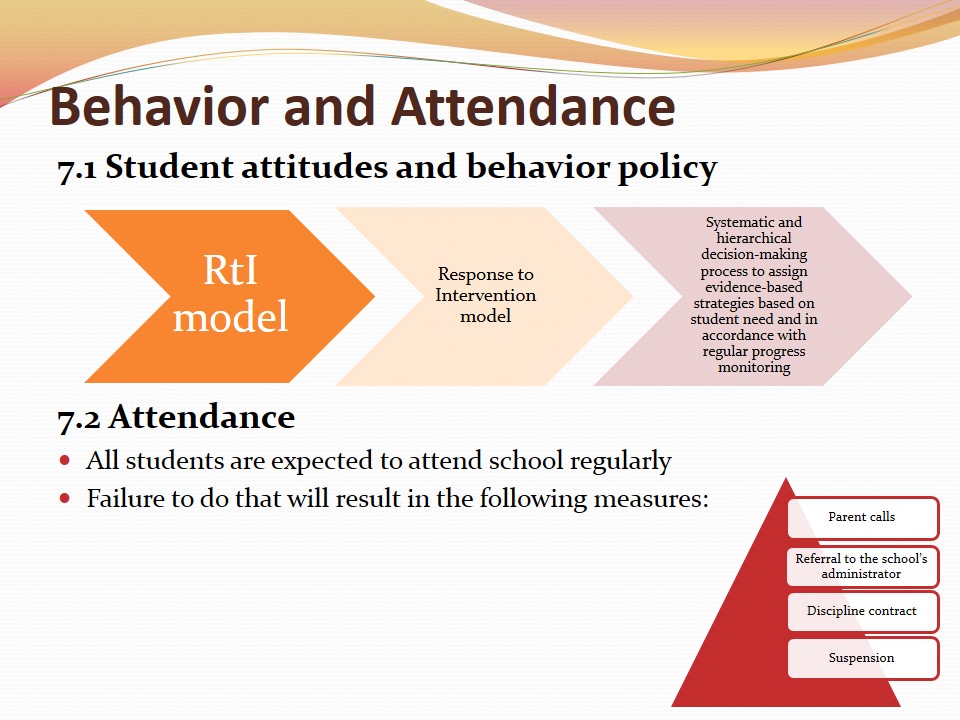
Student services
- Counselling:
- Free and confidential professional counselling services for all students.
- Career guidance:
- The school’s staff will help its students to clarify their career goals.
- Student safety:
- Private security guards – a safe educational environment.
- Food:
- Healthy meals in cafeteria.
- Health:
- School’s health center: safe and efficient primary health provision, help in medical crisis situations, immunization monitoring by an advanced practitioner nurse (APN).
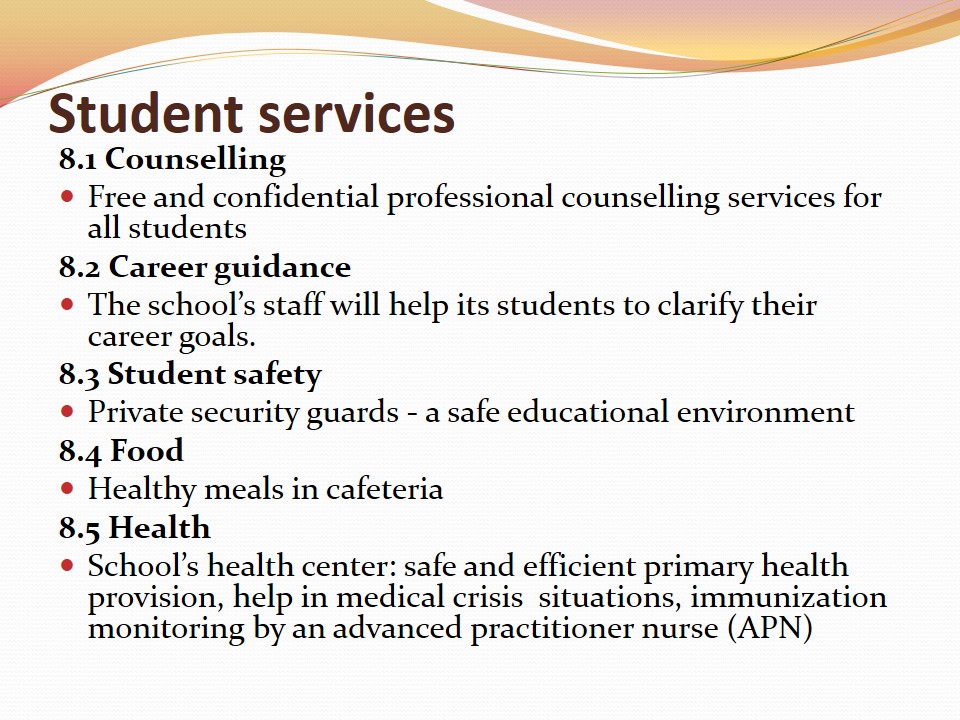
Human Resources
- Governance structure:
- Governing body.
- Head teacher and senior leaders.
- Investors.
- The performance and standards committee.
- The finance and resource committee.
- School management (Table 5):
- Teachers (Table 6):
- Administrative and other staff (Table 7):
- Recruiting and hiring:
- Teaching staff and the manager:
- Accountable to the school
- School’s manager:
- Responsible for recruitment of new teachers.
- Staff qualifications.
- KHDA:
- Responsible for assigning the principal.
- Teaching staff and the manager:
- Performance evaluation (appraisal):
- Continuing contract teacher.
- Beginning probation teacher.
- Experienced probationary teacher.
- Professional development Teacher requirements (70 hours of training over 3 academic years):
- Accredited training programs (40 hours).
- Priority programs (20 hours).
- Personal professional development (10 hours).
- Remuneration and allowances:
- Primary school teachers’ total pay
- AED 45, 424 (salary AED 45, 175 and bonus AED 249.88).
- Secondary school teachers’ total pay
- AED 34, 272 (salary AED 32, 149 and bonus AED 2,123).
- Primary school teachers’ total pay
Leaders of the Future School’s team of governors carries out numerous duties the most important of which are to oversee the strategic direction of the institution, hold the head teacher accountable, and ensure that resources of the school are effectively spent. The team also helps to form the school’s curriculum and participates in the appointment and dismissal of staff.
The full governing body of the educational institution helps to maintain a strong link with the local community. The body operates on a strategic level, whereas the head teacher along with the senior leadership of the school are responsible for internal organization and control of the institution (DES, 2015). Leaders of the Future School’s investors influence the school’s vision and direction through the governing body. The body also holds teachers accountable for their performance and controls resource allocation. The performance and standards committee is occupied by five governors who help the school to fulfil its legal requirements, ensure its policies are followed, and control self-evaluation procedures among other duties (DES, 2015). The school’s finance and resource committee is responsible for drafting a budget for a year and ensuring that the school follows the standards set in its financial documents.
- Table 6. Teaching posts in Leaders of the Future School.
- Table 5. Lines of Reporting in Leaders of the Future School.
- Table 7. Administrative and Other Staff of Leaders of the Future School.
Staffing needs will be evaluated at the beginning of each school year.
Performance evaluation: During the first cycle, professional growth plan will be monitored. In addition, continuing contractor teachers will be subjected to two classroom observations, one post-observation conference, and one summative planning conference twice a year (NCTQ, n.d.). Beginning probationary teacher will require similar evaluating procedures; however, they will be conducted once a year. Experienced probationary teachers will be subjected to the evaluation procedures every three years.
Medical and transportation expenditures will be reimbursed.
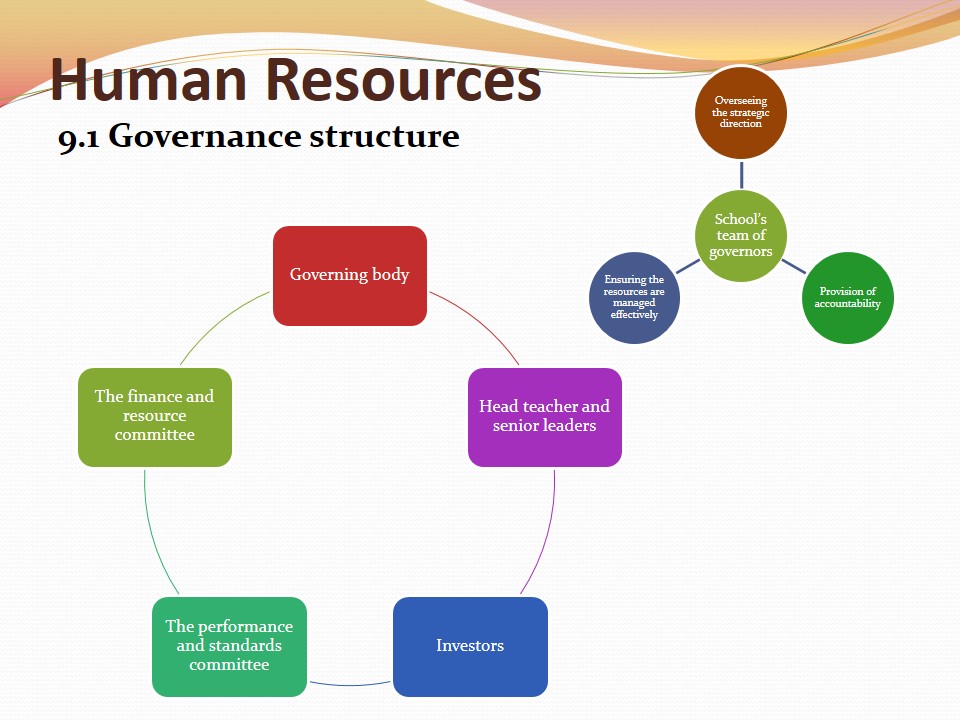
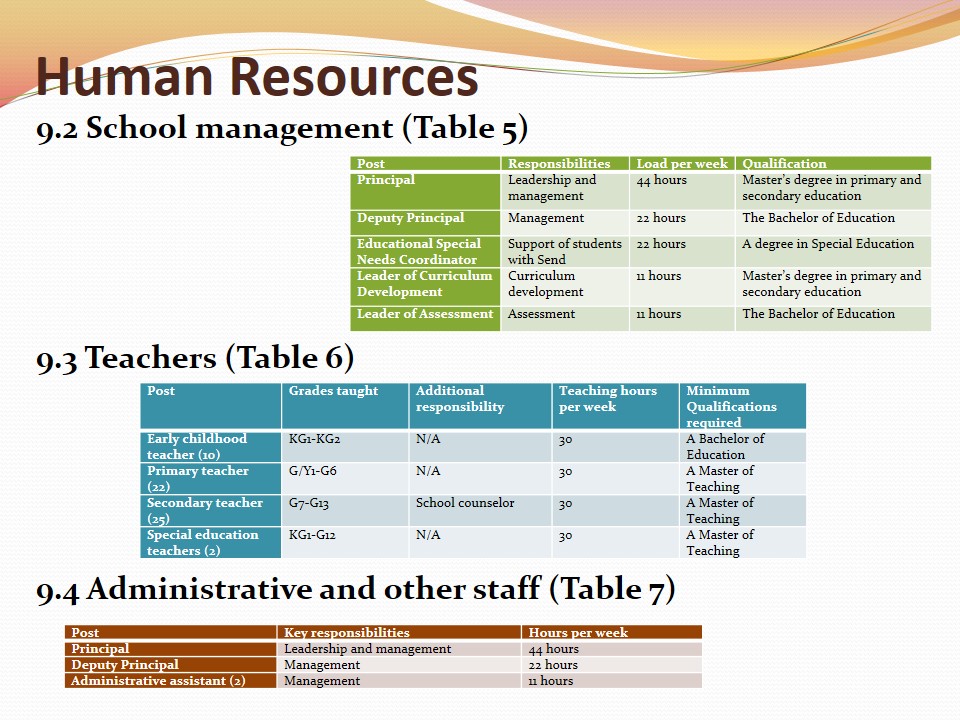


Financial plan
Financial policies and procedures:
- Charges:
- Application fee;
- Tuition fee;
- Registration fee;
- Transport fees.
- Application fee: 120 AED
- Registration fee:
- 10% of tuition fee (for returning students).
- 30% of tuition fee (for new students).
Breakdown of fees (Table 8):
- Start-up budget:
- Estimated budget for Leaders of the Future School: AED 3,200,000.
- Operational budget (Table 9):
Financial surplus:
- Prudent interest cover ratio: set at three times of school’s interest expense
- Surpluses will be spent according to PDP (premises development plan )
- Areas of investment: structural and building, classroom refurbishments, office space refurbishments, external space, health and safety, and security
